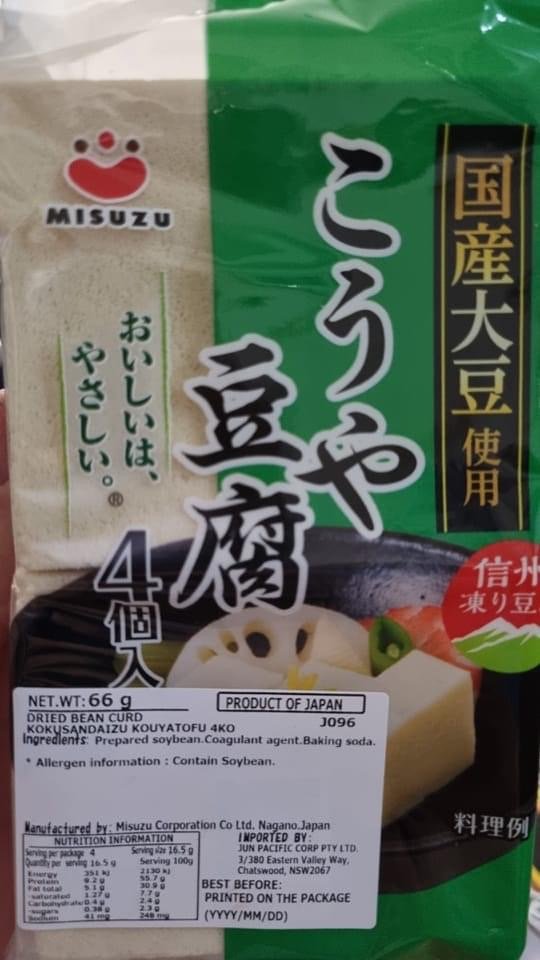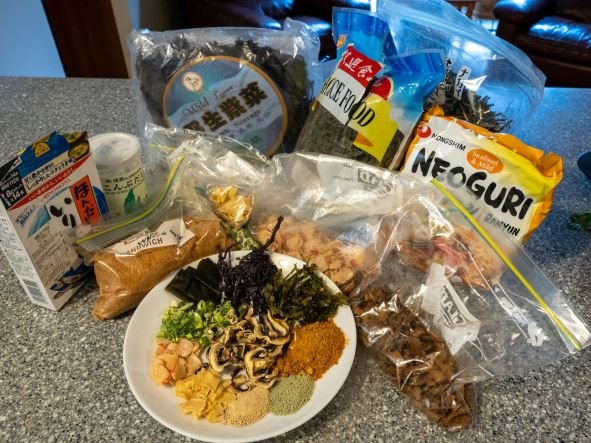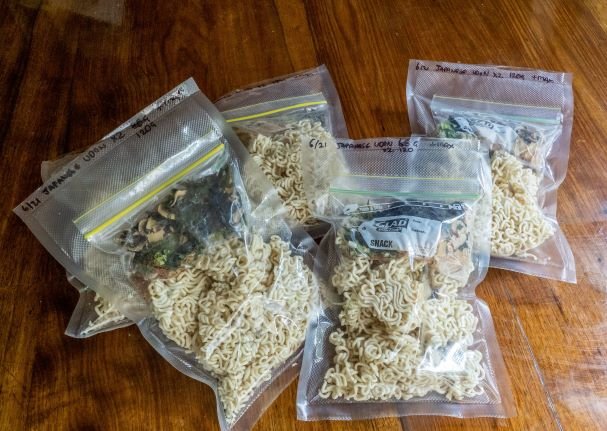DIY Dehydrating for Hikers who Hate Cooking
Are you the cook on the left, or the one on the right?
Either way, you can dehydrate your own hiking meals!
The recipes and techniques for creating main meals I’ve describe elsewhere are for people who enjoy cooking, with lots of fresh vegetables, herbs and spices, and few pre-packaged products. Every recipe also includes Cheat’s Hacks to simplify, streamline or short cut ingredients or processes for those who don’t enjoy cooking, or are time-poor.
However, even if you don’t cook, you don’t need to buy expensive backpacking freeze-dried meals: numerous supermarket products can be incorporated or adapted into dehydrated camping meals, or you can add your own dehydrated vegetables or meat to bulk up and improve the nutrition of pre-packaged ones. Follow these simple tips to get the most bang from the least amount of prep.
1. Find Quick-Cooking Dehydrated Products in your Supermarket
This freeze dried shelf stable tofu is a great addition to the backpacking pantry (Image Credit: Misuzu Corporation Co. Ltd)
Flavoured couscous
Instant nested angel hair pasta
Dried peas (the US has many more dehydrated vegetables than we do in Oz)
Sliced dried mushrooms (Asian supermarkets)
Bean curd sheets (Asian supermarkets)
Shelf stable freeze dried tofu
Seaweed (Asian supermarkets)
Dried shrimp (Asian supermarkets)
Dried fried onion
Sachet powders – chili con carne, bolognese, mornay/cheese, stir fry, bourginon, etc
Rice or pasta based ready-meals.
Check the instructions and choose ones that have shorter “cooking” times around 15 minutes: you’ll be pouring over boiling water and letting them “cook” in the cosy for double the time.
Milk and coconut powders: Great fat/ calorie boosters to add creaminess to soups and stews.
Be aware that coconut milk powder is very low in protein.
Meal-replacement powder eg Sustagen from chemists. These are nutrient dense, balanced, and unsweetened ones can be used instead of milk powder.
Shelf stable parmesan
Powdered egg
Freeze dried vegetables (these are ridiculously expensive)
Tuna sachets – these aren’t dehydrated but are nutrient dense, along with
Jerky, biltong.
TVP (textured vegetable protein) including flavoured ones
Curry powders, soups and sauce sachets can all be incorporated into dehydrated camping meals.
Add dehydrated vegetables to beef up instant soup
Asian stores also have a huge range of dehydrated foods including:
Seaweed, shrimp, mushrooms and bean curd
2. You can also get dried vegetables and powders online:
https://herbsandspicesaustralia.com/product/tomato-powder-100-pure-for-italian-cooking/
https://thegraingrocer.com.au/product-category/dried-vegetables/
Some dried products sound great, but really aren’t. High-fat products like peanut butter, butter and high-fat cheeses have various things done to them and often end up just 30% lighter than the originals. Powdered peanut butter is low calorie without any of its fat. Powdered butter has lots added to it, so it’s not much lighter either.
If you’re hiking for a week or two, these processed foods won’t do you much harm. However, long distance hikers are much better with home dehydrated food or good quality commercial freeze dried meals because eating processed food that is high in sugar and salt for so many months can affect your health.
3. Dehydrate Just Four Things at Home
If you can manage to dehydrate just a few things at home, the following four will save you a lot of money and greatly increase the variety and deliciousness of meals open to you.
i. Minced Meat.
Cook, rinse and dehydrate minced meat as described in our How to Adapt Favourite Recipes post but mix through 1 cup dry breadcrumbs per kg before frying to prevent meat from turning into gravel. Add to
Instant pasta, add powdered sachet sauce
Taco mix powder and tacos
Flavoured couscous
Instant soup sachets
Supermarket dehydrated pasta meals
Instant Rice
Ramen Noodles
Quinoa; add spices and dried vegetables
Rice Flakes
Boost instant meals like this with jerky, mince, tuna, and dried vegetables
They’ll taste better too!
ii. Mixed dehydrated vegetables.
One of the most versatile additions to your camp pantry is dehydrated mixed dried vegetables. Add them to instant soup, ramen and packet meals. I dehydrate my own fresh ones, with both a leafy green veg one (kale, spinach, spring onion, broccoli, cauli, Tuscan cabbage, cabbage, leek, parsley) that rehydrates very quickly in soups, and a mixed veg one that also contains root vegetables, peas, corn and green beans, which takes a little longer to rehydrate.
Home dehydrated veg are easy and delicious, but time consuming to make because everything needs to be diced small and most veg need to be steamed or blanched before dehydrating.
It’s cheap and easy to do but there are alternative approaches.
If you’re time poor, you can dehydrate frozen vegetables, or buy dehydrated ones. Backpacker freeze dried ($9.95 for 90g) or even dried ones ($12.95 for 45g) are expensive; take a look at cheaper options in Oz (price at time of writing):
https://www.lastingharvest.com.au/shop?Category=Soup+Mixes+%26+Sauces $9.50 for 120g or $19 for 650g
iii. Dehydrate tinned lentils and beans
No cooking required, just drain and spread on trays.
And in any case, these generally rehydrate faster and better than ones you cook from raw yourself.
iv. Miso paste
Dehydrated miso paste packs a massive flavour punch and is incredibly good for you. Use like stock cubes in any savoury dish, not just Asian ones!
4. Choose Your Own Adventure
When you buy dehydrated products, don’t be afraid to mix and match them to create variety and to match your taste and appetite. However you do it, it will still be cheaper than buying freeze dried backpacking meals. The following method is how many hikers prepare their backpacking dinners.
a. Choose your Carb:
Instant pasta (eg angel hair nests)
Quinoa
Rice flakes
Instant Rice
Corn Chips
Tacos
Ramen
Rice Noodles
Dried mashed Potato (Deb)
Couscous
Couscous – pour over boiling water and five minutes later you’re done.
But add mince and vegetables, and it will actually taste good!
b. Add Protein
Dehydrated minced meat
Dried bean curd sheets (snip into strips or squares)
Dehydrated Vegie Mince (TVP)
Dried shrimp
Dehydrated tinned pulses
Tuna sachets (keep separate until rehydrating)
Nuts and seeds
Jerky, biltong
Powdered egg
Milk powder
Tuna is heavy but very high in protein. We usually carry a few sachets for lunch, but not exclusively. For dinners, combine with cheese sauce, pasta, peas and corn for a power-packed mornay.
Add jerky to soups or rice.
c. Add Dried Vegies
Home Dried vegie mix
Commercial dried vegie mix
Individual dried vegetables or powders eg mushrooms, tomato, peas.
d. Add seasoning, spices or sauces
Cupboard herbs and spices (salt, pepper, ground ginger, chilli, cumin, mixed spices etc)
Packet soups
Packet sauces.
Packet spice blends are handy additions to the backpacking pantry!
Or can simply be used to give a more elaborate meal a taste boost
You might like to try …..
Udon Noodles, seaweeds, mushrooms, fried dried onion, bean curd, miso soup powder.
My Japanese style udon noodle recipe has home dried mushrooms, tofu, seafood sticks, spring onion and miso in them, but you can replicate this entirely from the supermarket with dried sliced shiitake, bean curd strips, dried fried onion and miso soup packets. I don’t dry my own seaweed but buy it from the supermarket too!
Or perhaps:
Instant pasta, dried peas, dried corn, tuna sachet, cheese sauce. OR add dried peas, corn and tuna to a dried carbonara pasta meal.
Instant rice, dehydrated vegetables, Chinese stirfry sachet, bean curd strips.
Flavoured couscous, dried veg, TVP or mince.
Corn chips, dried canned beans and/or mince, dried onions, nacho or taco sauce sachet.
All kinds of ramen or instant noodle recipes
And there you have it: your own camping dinners prepared entirely or mostly from purchased ingredients, limited only by your imagination and your hip pocket!














